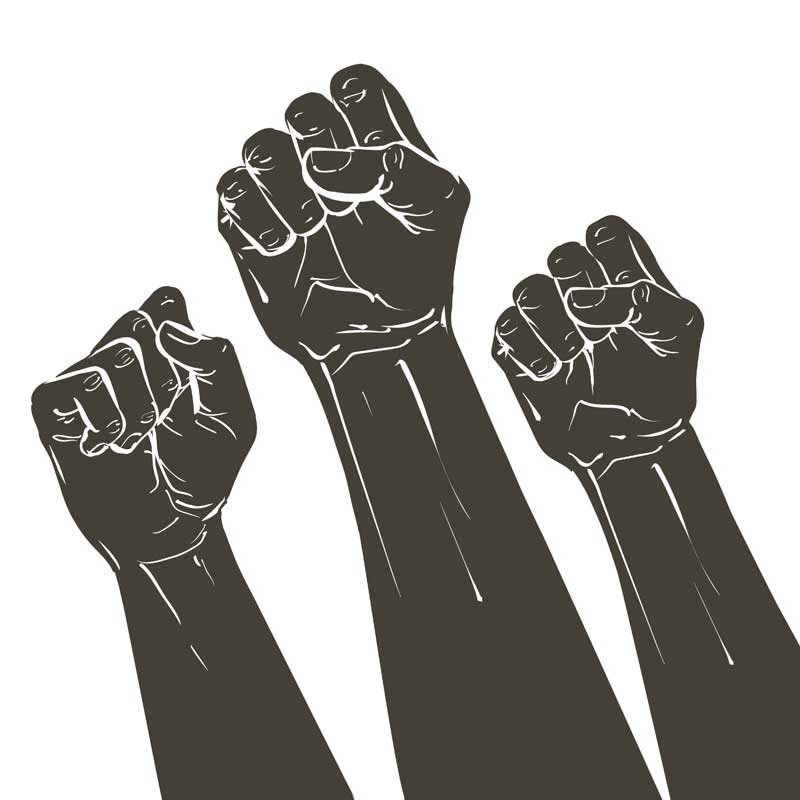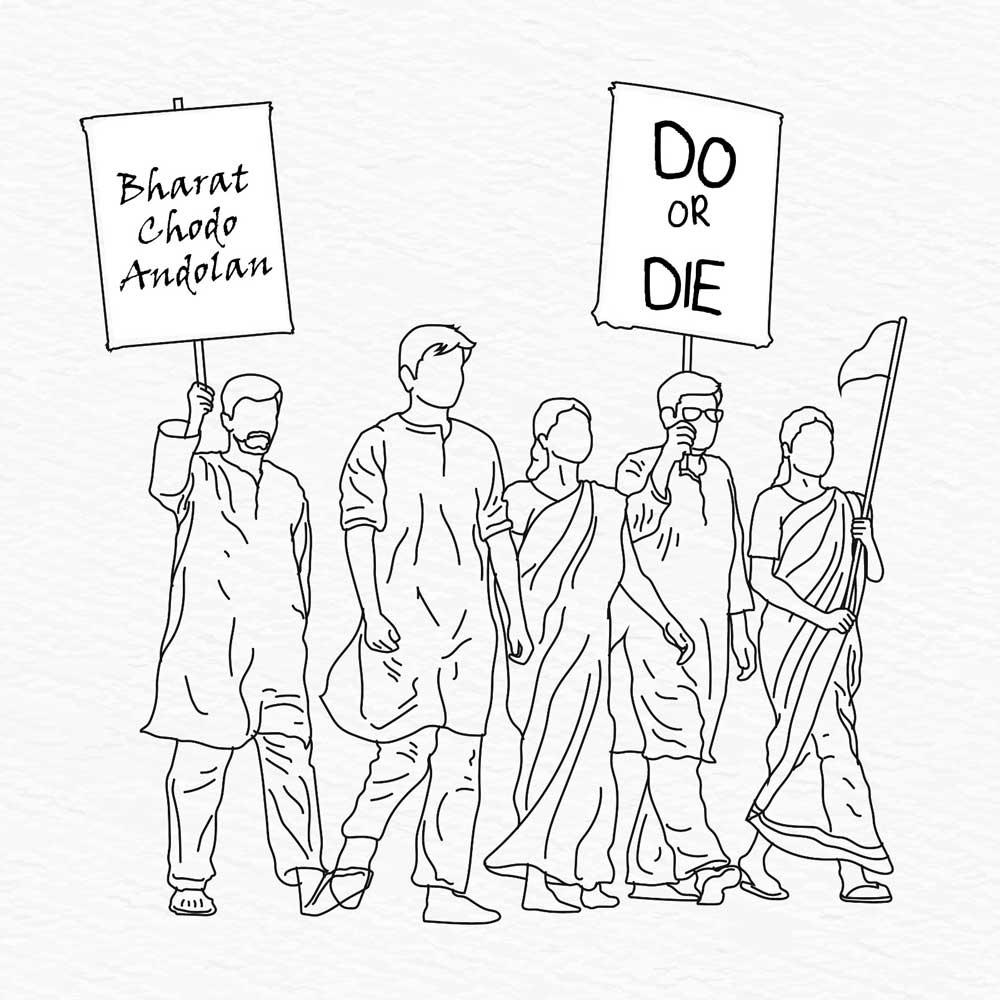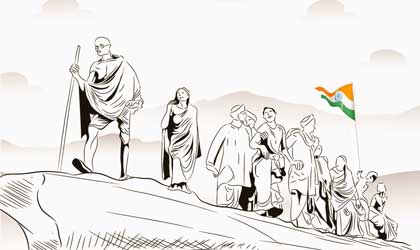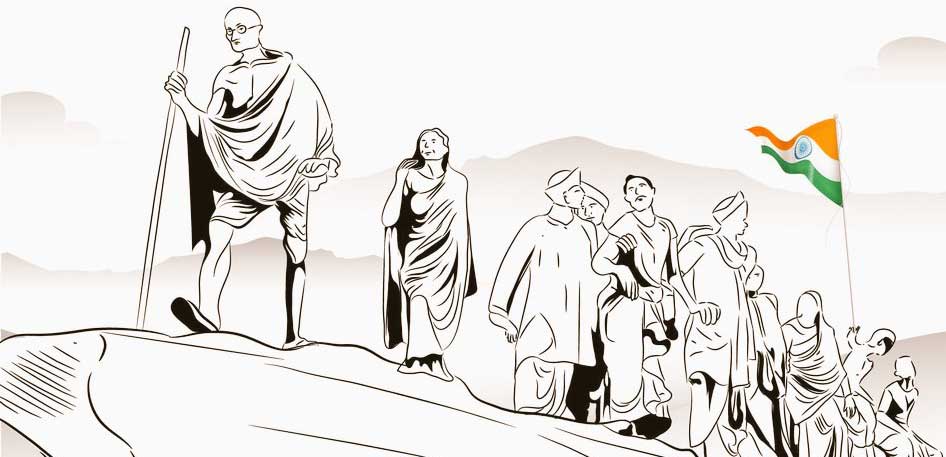A Watershed Moment in India’s Fight for Freedom
A mass Movement was launched on 8th August 1942, marking it a very crucial in India’s struggle for independence from British colonial rule. This movement is known as quit India movement which was led by Mahatma Gandhi and supported by a many of the freedom fighters. The Quit India Movement, also known as the August Movement or Bharat Chodo Andolan, was a turning point in the freedom struggle of our motherland. It was a significant civil disobedience movement led by Mahatma Gandhi and the Indian National Congress during World War II.
The movement aimed to demand an immediate end to British colonial rule in India and establish a sovereign and independent nation. The slogan “Quit India” encapsulated the demand for the British to leave India. This movement represented a culmination of years of nonviolent resistance and civil disobedience
Chronology
 Seeds of Dissent: By the early 1940s, India had been under British colonial rule for nearly two centuries. The demand for self-rule and independence had grown significantly and various factors contributed to the rising tide of dissent. The oppressive policies of the British Raj, coupled with the economic exploitation of India’s resources, had deeply resonated with the masses. Additionally, the effects of World War II further catalyzed and fueled the agitation for complete autonomy.
Seeds of Dissent: By the early 1940s, India had been under British colonial rule for nearly two centuries. The demand for self-rule and independence had grown significantly and various factors contributed to the rising tide of dissent. The oppressive policies of the British Raj, coupled with the economic exploitation of India’s resources, had deeply resonated with the masses. Additionally, the effects of World War II further catalyzed and fueled the agitation for complete autonomy.
 Call to Action: As the torchbearer of nonviolent resistance, Mahatma Gandhi realized that the time had come for a decisive action that would shake the foundations of British rule in India. In his call for the Quit India Movement, he emphasized the need for immediate withdrawal of British forces and the establishment of a truly democratic government. He gave the slogan of “Do or die” during this movement.
Call to Action: As the torchbearer of nonviolent resistance, Mahatma Gandhi realized that the time had come for a decisive action that would shake the foundations of British rule in India. In his call for the Quit India Movement, he emphasized the need for immediate withdrawal of British forces and the establishment of a truly democratic government. He gave the slogan of “Do or die” during this movement.
 Mass Mobilization at Peak: The Quit India Movement witnessed widespread participation from people across various regions, religions, backgrounds, caste and gender also. Millions of Indians joined the call of “Quit India movement” which leads to strikes, demonstrations and acts of civil disobedience that paralyzed normal life in many parts of the country.
Mass Mobilization at Peak: The Quit India Movement witnessed widespread participation from people across various regions, religions, backgrounds, caste and gender also. Millions of Indians joined the call of “Quit India movement” which leads to strikes, demonstrations and acts of civil disobedience that paralyzed normal life in many parts of the country.
Repression: The British responded to the Quit India Movement with brutality, they used tactics such as mass arrests, police violence and repression of civil liberties. However, these measures only fueled the determination of the Indian populace to achieve their goal of freedom.
Impact: The Quit India Movement marked a turning point in India’s fight for independence, as it demonstrated the unity, resilience and determination of the Indian people in the face of adversity.
While immediate success in achieving complete independence was not achieved by this movement. It set the stage for future negotiations and discussions that ultimately paved the way for India’s freedom in 1947.
Remembering the Spirit of Quit India
 As we commemorate the Quit India Movement on its anniversary, it is important for us as Indian citizen to understand the sacrifices made by our leaders and their unwavering commitment to a free and just society. This movement serves as a reminder to us that the path to freedom is full of challenges but determination is the only weapon through which we can achieve anything. The lessons of the Quit India Movement continue to resonate in today’s world, where struggles for justice, equality and human rights persist. Let us pledge on this day as Indian citizen to uphold the principles of democracy, unity, justice always.
As we commemorate the Quit India Movement on its anniversary, it is important for us as Indian citizen to understand the sacrifices made by our leaders and their unwavering commitment to a free and just society. This movement serves as a reminder to us that the path to freedom is full of challenges but determination is the only weapon through which we can achieve anything. The lessons of the Quit India Movement continue to resonate in today’s world, where struggles for justice, equality and human rights persist. Let us pledge on this day as Indian citizen to uphold the principles of democracy, unity, justice always.
India history of independence has a long journey with lots of ups and downs. There are some crucial events which has completely changed our destiny as Indian. It was started with the Indian Revolt of 1857 and then finally ends with India’s independence in 1947.
Here is a quick glance:
- Indian Rebellion of 1857 (Sepoy Mutiny or First War of Independence)
- Formation of Indian National Congress (1885)
- Partition of Bengal (1905) and Swadeshi Movement
- Home Rule Movement (1916-1918)
- Jallianwala Bagh Massacre (1919)
- Non-Cooperation Movement (1920-1922)
- Civil Disobedience Movement (1930-1934)
- Quit India Movement (1942)
- Royal Indian Navy Mutiny (1946)
- Indian Independence (1947)
Written by: Mohd. Talib Khan




